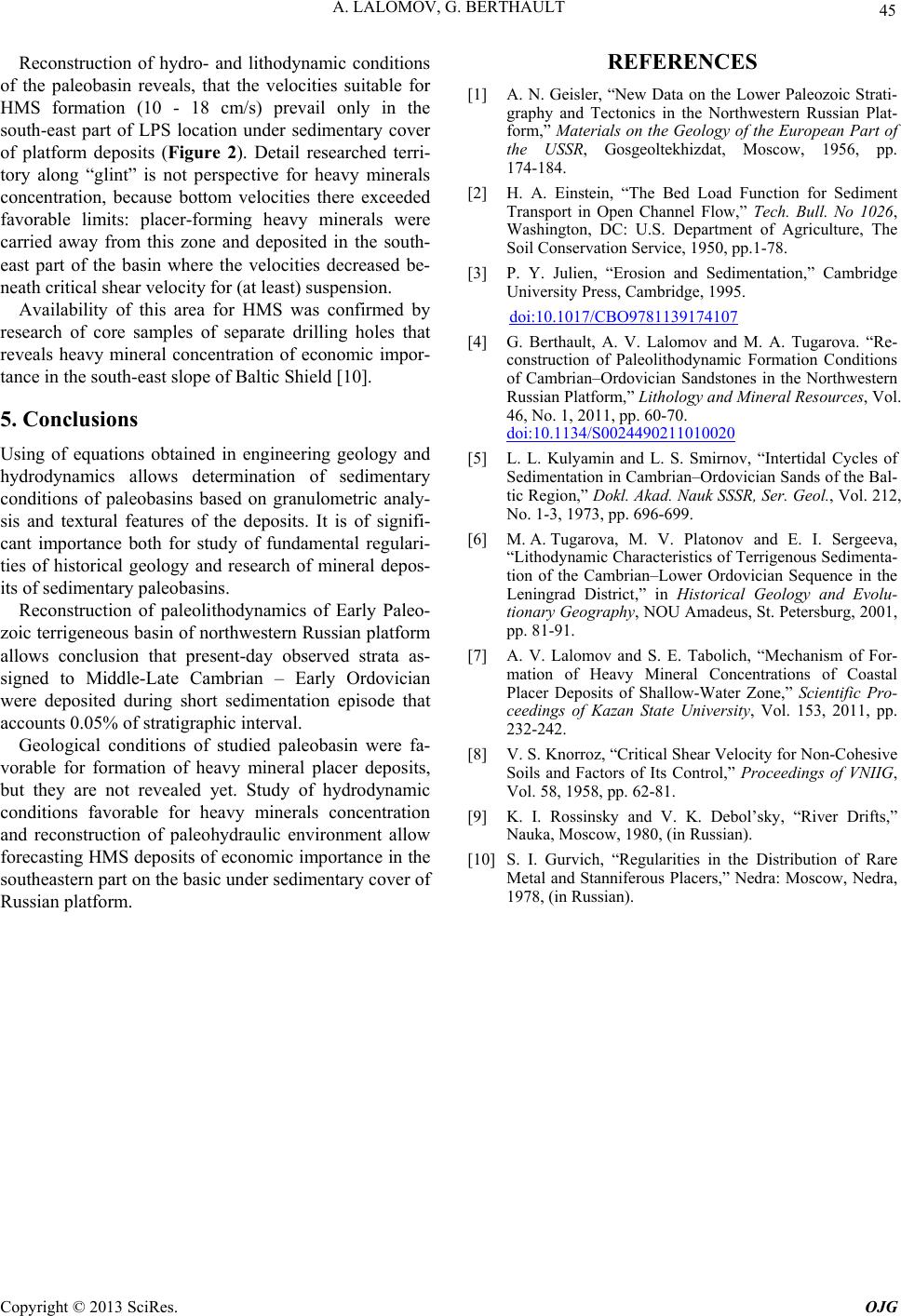
A. LALOMOV, G. BERTHAULT 45
Reconstruction of hydro- and lithodynamic conditions
of the paleobasin reveals, that the velocities suitable for
HMS formation (10 - 18 cm/s) prevail only in the
south-east part of LPS location under sedimentary cover
of platform deposits (Figure 2). Detail researched terri-
tory along “glint” is not perspective for heavy minerals
concentration, because bottom velocities there exceeded
favorable limits: placer-forming heavy minerals were
carried away from this zone and deposited in the south-
east part of the basin where the velocities decreased be-
neath critical shear velocity for (at least) suspension.
Availability of this area for HMS was confirmed by
research of core samples of separate drilling holes that
reveals heavy mineral concentration of economic impor-
tance in the south-east slope of Baltic Shield [10].
5. Conclusions
Using of equations obtained in engineering geology and
hydrodynamics allows determination of sedimentary
conditions of paleobasins based on granulometric analy-
sis and textural features of the deposits. It is of signifi-
cant importance both for study of fundamental regulari-
ties of historical geology and research of mineral depos-
its of sedimentary paleobasins.
Reconstruction of paleolithodynamics of Early Paleo-
zoic terrigeneous basin of northwestern Russian platform
allows conclusion that present-day observed strata as-
signed to Middle-Late Cambrian – Early Ordovician
were deposited during short sedimentation episode that
accounts 0.05% of stratigraphic interval.
Geological conditions of studied paleobasin were fa-
vorable for formation of heavy mineral placer deposits,
but they are not revealed yet. Study of hydrodynamic
conditions favorable for heavy minerals concentration
and reconstruction of paleohydraulic environment allow
forecasting HMS deposits of economic importance in the
southeastern part on the basic under sedimentary cover of
Russian platform.
REFERENCES
[1] A. N. Geisler, “New Data on the Lower Paleozoic Strati-
graphy and Tectonics in the Northwestern Russian Plat-
form,” Materials on the Geology of the European Part of
the USSR, Gosgeoltekhizdat, Moscow, 1956, pp.
174-184.
[2] H. A. Einstein, “The Bed Load Function for Sediment
Transport in Open Channel Flow,” Tech. Bull. No 1026,
Washington, DC: U.S. Department of Agriculture, The
Soil Conservation Service, 1950, pp.1-78.
[3] P. Y. Julien, “Erosion and Sedimentation,” Cambridge
University Press, Cambridge, 1995.
doi:10.1017/CBO9781139174107
[4] G. Berthault, A. V. Lalomov and M. A. Tugarova. “Re-
construction of Paleolithodynamic Formation Conditions
of Cambrian–Ordovician Sandstones in the Northwestern
Russian Platform,” Lithology and Mineral Resources, Vol.
46, No. 1, 2011, pp. 60-70.
doi:10.1134/S0024490211010020
[5] L. L. Kulyamin and L. S. Smirnov, “Intertidal Cycles of
Sedimentation in Cambrian–Ordovician Sands of the Bal-
tic Region,” Dokl. Akad. Nauk SSSR, Ser. Geol., Vol. 212,
No. 1-3, 1973, pp. 696-699.
[6] M. A. Tugarova, M. V. Platonov and E. I. Sergeeva,
“Lithodynamic Characteristics of Terrigenous Sedimenta-
tion of the Cambrian–Lower Ordovician Sequence in the
Leningrad District,” in Historical Geology and Evolu-
tionary Geography, NOU Amadeus, St. Petersburg, 2001,
pp. 81-91.
[7] A. V. Lalomov and S. E. Tabolich, “Mechanism of For-
mation of Heavy Mineral Concentrations of Coastal
Placer Deposits of Shallow-Water Zone,” Scientific Pro-
ceedings of Kazan State University, Vol. 153, 2011, pp.
232-242.
[8] V. S. Knorroz, “Critical Shear Velocity for Non-Cohesive
Soils and Factors of Its Control,” Proceedings of VNIIG,
Vol. 58, 1958, pp. 62-81.
[9] K. I. Rossinsky and V. K. Debol’sky, “River Drifts,”
Nauka, Moscow, 1980, (in Russian).
[10] S. I. Gurvich, “Regularities in the Distribution of Rare
Metal and Stanniferous Placers,” Nedra: Moscow, Nedra,
1978, (in Russian).
Copyright © 2013 SciRes. OJG